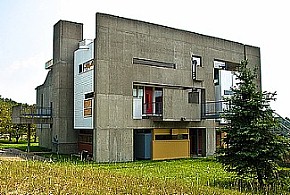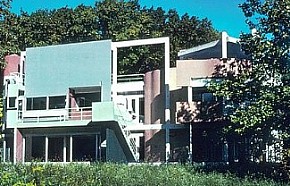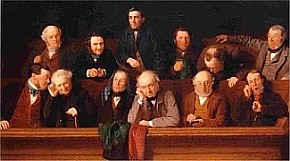2008.05.16 10:29
Now try taking it to court.
"The late period of artists is often under-rated. Picasso's Late Period was mostly disliked while he was alive--seen as repetitious and unimportant. Yet with Picasso dead, the late works were not so unimportant anymore, in fact they manifest one of Picasso's most creative periods.
Frank Gehry may be in a wonderful position if he continues to do architecture for another decade or so, because, when he isn't around anymore, his late works might just manifest his most creative period.
I like to look at and study the late periods of artists because of all the facile-ness and confidence and even (if you're lucky) the "I don't give a fuck" found there.
Philip Johnson produced an interesting late period, and he did change 'styles' with every new project, yet his overall style has always been reenactionary architecturism."
Rita Novel, 2005.08.23
If lateness does contain the possibilities of a new future paradigm, then I certainly hope the new paradigm is facile, confident and without giving a fuck. [Personally, I'm already moving from my early don't-give-a-fuck style to my high don't-give-a-fuck style, and God only knows what my late don't-give-a-fuck style is going to be like.
"Frankly, Stella, I don't give a damn."
I see a lot of late Le Corbusier meets universal Mies van der Rohe meets early planning Louis I. Kahn in the work of OMA, etc. Just one recent example: look at Kahn's Midtown [Philadelphia] Development (1956-57) and OMA's Quartier des Halles Urban Development Study (2003-04). And every time I now see Kahn's AFL-CIO Medical Services Center, I immediately also think of Herzog & de Meuron. There's a lot of mostly untapped inspiration within the unbuilt and lesser known architectural designs of the 20th century.
Does the science of recombinant genetics and even cloning harbor a new paradigm for architecture? Like the science, I think it's already happening within architecture, but, also like with the science, it's a paradigm that many would rather deny.
2008.05.16 11:09
The Official Paradigm Shift thread
"For example there were reasons in the late 19th century for architecture to change. These included changes in psychology introduced by Freud; in physics by Einstein; in mathematics with Heisenberg; and in flight with the Wright brothers. These changes caused a reaction against the Victorian and imperial styles of the period and articulated a new paradigm: modernism."
What the physics of Einstein, the mathematics of Heisenberg and the flight of the Wright brothers changed much more than architecture was warfare. [Freud basically applied the Christian notion of divine trinity being to the human psyche, thus helping humans to see themselves (and even Freud himself) as more Christian god-like.]
"With each new paradigm, whether it is the French revolution or the Renaissance, there is an early phase, which in modernism was from 1914-1939; a high phase, which in modernism occurred 1954-1968 when it was consumed by liberal capital after the war; and a period of opposition. The year 1968 saw an internal, implosive revolution, one that reacted against institutions representing the cultural past of many of the western societies. This was followed by post modernism's eclectic return to a language that seemed to have meaning. The Deconstructivist exhibition at the MoMA in 1988 put an end to this cliché and kitsch style."
First off, I wonder what the early, high and post-modern phases of the French Revolution are.
Note how modernism (as described here) does not have a phase between 1939 and 1954, i.e., during WWII and its aftermath. It looks like WWI and WWII and even the Vietnam War had a far greater effect on modernism than anything else.
So what does "war" look like in the world of architecture? Maybe, just maybe, it looks like a complete inversion of all of the above. (Like I said already, paradigm shifts require a lot of work.)
| |
2008.06.28 09:21
the miller house (should be more famous)
 Looks like late Le Corbusier style as Composite Order--Villa Shodham meets Heidi Weber Pavilion meets Chandigarh tapestries.
Looks like late Le Corbusier style as Composite Order--Villa Shodham meets Heidi Weber Pavilion meets Chandigarh tapestries.
What was the year of construction?
Evokes some memories of Graves' Snyderman House.

2008.06.30 15:24
the miller house (should be more famous)
"Ah, Detailotheca, the nimiety of detail museum."
"If only all architecture were so self-evident."
"I know. It never really was a house, was it?"
"True, but it's actually two museums."
"Ah yes, the Reenactment of Late Le Corbusier Style Museum as well."
2008.07.21 09:02
bored with modern & contemporary, yet?
"What Stein discovered was a writing style that celebrated its grammatical mistakes. In her most radical prose, she managed to make us conscious of all the linguistic work that is normally done unconsciously. We notice the way verbs instantly get conjugated (even irregular verbs), the way nouns naturally become plural, and the way we amend articles to fit their subjects. Stein always said that the only way to read her writing was to proofread it, to pay acute attention to all the rules she violates. Her errors trace the syntactical structures we can't see, as our "inside becomes outside."* Stein showed us what we put into language by leaving it out."
* This isn't as strange a method as it might seem. Ludwig Wittgenstein hit upon a similar method for his philosophy, which, like Stein's writing, was interested in the uses of language to the exclusion of almost everything else. Wittgenstein once said that he worked by "mak[ing] a tracing of the physiognomy of every [philosophical] error." Only by mapping out mistakes could he see how best to proceed. Samuel Beckett also subscribed to Stein's literary approach. "Let us hope that a time will come," Beckett wrote, "when language is most efficiently used where it is being misused. To bore one hole after another in it, until what lurks behind it--be it something or nothing--begins to seep through; I cannot imagine a higher goal for a writer today."
Jonah Lehrer, Proust was a Neuroscientist (2007), p. 164.
Here we have 'modernist' thinking.
Alberti's thinking appears more Platonic.
Michelangelo's thinking appears more Aristotelian.
| |
2008.08.09 07:46
Adam (sans Eve) in the Garden of Satire
who knew?
A rich and storied past surrounds the Mansfield Hotel, located on famed Club Row, one of the most prestigious and history laden blocks in New York City.
Prior to the Mansfield’s construction in 1903, an orphanage occupied the same real estate until 1867, followed by a three-story brick stable that was built to service the opulent mansions along Fifth Avenue owned by the era’s social “elite”, including notables such as the Vanderbilts, Goelets, Whitneys, Goulds and the Mills.
Then in 1890, one of the most celebrated Architects of the era, James Renwick, was retained to design the Mansfield Hotel. His masterful works include Saint Patrick’s Cathedral, The New York Public Library and St. Bartholomew’s Church, as well as many other historic buildings throughout the city.
Constructed in the popular Beaux Arts style, and influenced by neoclassical Roman and Greek architecture, the Mansfield was originally built as a hostelry for well-heeled bachelors and socialites. Notables such as painter John Butler Yeats, father of the poet William Butler Yeats, stayed to experience a thriving New York following his immigration from Ireland. During the 1950s, the Mansfield was home to Maz von Gurach, who was believed to be the inspiration for Jay Gatsby, from F. Scott’s Fitzgerald’s “The Great Gatsby.” During the 1970s, the Mansfield was pictured in the dictionary under seedy, and the very rare overnight guest heard room doors opening and closing at all hours.
2008.09.05 08:43
MVRDV masterplan in Tirana
It's not geo-mimicry, it's jury-mimicry!

"Hey, let's design a reenactment of this painting."
"Yeah, we'll do it like abstractly, and when other architects see the scheme they'll start reenacting a design jury."
"Brilliant!"
--excerpt from "Scalping Double Theater Tickets" in The Further Adventures of the Broke Baroque Style.
2008.10.02 08:58
Reenactionary Architecturism
1997.01.20
The plan, section, and elevation data displayed at the same scale and in strict chronological order, as opposed to displayed by country, type, style, or architect.
...the idea of a museum of architecture displayed in strict chronological order.
| |
2008.10.05 11:20
Mixing Design Elements of Different Style Homes-Your Opinion
There's really nothing stopping you from mixing whatever you want. Unless, of course, you wear your education like a Playtex girdle.
I try to go into eclectic shock/therapy at least once a week. Recently 2398 and 2399.
And I've been going into eclectic shock/therapy for 25 years now.
2008.10.06 10:39
Mixing Design Elements of Different Style Homes-Your Opinion
forget utopian and go ottopian
2008.10.06 14:10
Mixing Design Elements of Different Style Homes-Your Opinion
This week I'm designing a pre-quondam and post-quondam mix residence.
2009.06.16 12:04
please comment or destroy, thank you
I can well see that scripting is an advancement in drawing dexterity with the aim of an advancement in production, but it's not altogether evident that scripting is an advancement in architecture.
Does scripting really generate a more enlightened, more liberal architecture?
For example, does scripting engender an architecture of maximum individual freedom? Does scripting engender an open-minded architecture or a more tolerant architecture?
Or does scripting really (only) come to engender a new style of architecture?
2009.08.17 09:10
Postmodernism sucks... discuss
Took the time to look through Jencks' The Language of Post-Modern Architecture (1977) and read a little from Part Three: 'Post-Modern Architecture:
"There articles and attacks, lasting from 1959 to 1962, were meant to wipe out these heresies with a little critical weed-killer, but in the event the Italians fought back at this Puritanism, the refrigerator school of criticism.
The kind of buildings which were provoking this debate all had vague or repressed historical allusions..."
"Here is the schizophrenic cross between two codes that is characteristic of Post-Modernism..."
"Saarinen couldn't quite go the next step and design conventional decoration."
"The historicism is attenuated, embarrassed, half-baked--a problem for many of the architects who left Mies setting out for decoration (and never quite arrived)."
"'We can not know history'.
So by 1961 we have at least a camp, laconic statement in favor of eclecticism."
"What, might be asked, is really wrong with the decorative use of traditional elements--indeed straightforward ornament and the Trad styles? No one was prepared in the sixties to pose these questions in a radical way, and so the vague modernist suspicion of ornament and convention remained.
I suppose the first Modernist architect to use the decorative moulding and traditional symbol (such as the doorway arch) in an aggressive way was Robert Venturi. His Headquarters Building (1960)..."
...where the colors have been homogenized, the windows changed, and only faint traces of the mouldings remain.
| |
2009.09.30 21:33
Information Architects Talking About Architects and Architecture
Presently, I like to design delivery of content in the enfilade slash labyrinth style.
Perhaps, someday, I'll design some delivery of content following the architecturale promenade formula.
Actually, I've been struggling with a big design/renovation brief, the solution to which has been eluding me for well over a month now. Alas, today, while just stepping out of the shower, it finally dawned on me--delivery of content in the enfilade slash labyrinth style via bilocation.
Is subtext actually text bilocated?
2010.12.29 17:02
Good Design - Change Lives
"It is shocking to realize how very limited the language of contemporary architecture has become though, with the passing of High Style MOD, we have the opportunity once more to expand our vocabulary and remember our architectural lineage. The front of Hawksmoor's church at Spitalfields (London) comprises at least a Gothic spire, a French arch-de-triumphe and a Roman basilica, and this free-wheeling construction of elements was something which Schinkel and many other architects could do well; one admires their facility and envies their vocabulary. Never in the past (MOD Architecture excepted) have architects so completely rejected previous architectural forms and now is perhaps the time to acknowledge our continuity and remember our cultural background, wherever we come from, and this must be more important than any attempt at outright historical revivalism.
Schinkel's houses in particular exemplify the transition between Classicism and Romanticism--a time when classical ornament was greatly diminished and Romantic fruitiness had not yet developed. When I visited Glienike in 1964 I was amazed at the small domestic scale and...
James Stirling, "Introduction and Comments" (to the House for K. F. Schinkel Shinkenchiku Residential Design Competition) in The Japan Architect, February, 1980, p.50-1.
2011.01.24 21:18
what is our current architectural style called
Architecture style is no longer defined by space, rather by time.
"Their house is the epitome of 2002 style."
"Design me something early 1840s. I'm feeling immediate-post-Schinkel lately."
"In the year 2525, when architecture is finally alive..."
2011.01.25 12:25
what is our current architectural style called
The more true question is: What are our current architectural styles called?
There has never been just one style globally active at any given time. There are many diverse styles of architecture active today. Even within just a single year there are diverse styles active. For example,
1927
1930
1942
1956
1959
1964
1972
1983
1993
1996
2001
and that's just a very thin slice of any yearly cross-section.
I wonder if a worthwhile studio project might be to design a hypothetical '1963' building, for example, which would be a hybrid of a half dozen or so buildings that were actually dsigned or built in 1963.
Perhaps if there is a current Zeitgeist, it's one of individual (consumer) choice.
|